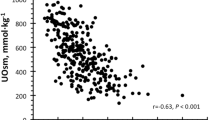Abstract
Hypercalciuria is a major risk factor for kidney stones and hematuria in children. Calcium measurements in 24-h collected urine (mg/kg/d) is still essential for the hypercalciuria diagnose but collection of 24 hour urine is difficult especially in young children. A prospective study was conducted to compare calcium/osmolality (Uca/Uosm) ratio to calcium/creatinine (Uea/Ucr) and to correlate both ratios to 24-hour urine calcium excretion (mg/kg/d) and the value of Uca/Uosm ratio for diagnosis of hypercalciuria in children. Two hundred and fifteen patients aged between 3 to 15 years (median 8 years) were included in the study. Early morining second urine samples and 24-hour collected urine samples were analyzed. The 24-hour urinary calcium excretions were significantly correlated with Uca/Ucr and Uca/Uosm ratio (r =0.67, P<0.001 and r =0.61, P<0.001 respectively). The accepted hypercalciuria level of 24-hour urine calcium of 4 mg/kg/day coincides with Uca/Ucr ratio of 0.18 mg/mg (sensitivity 90.0%, specificity 84.4%) and with Uca/Uosm ratio of 0.14 mg/l/mOsm/kg (sensitivity 90%, specificity 81.0%) in the ROC curve analysis. Positive and negative predictive values were found 98.3% and 39.1% for Uca/Uosm ratio and respectively 43.9% and 98.4% for Uca/Ucr ratio. In conclusion Uca/Uosm ratio is a good marker of hypercalciuria as well as Uca/Ucr ratio and may be used for screening of hypercalciuria.



Similar content being viewed by others
References
Vachvanichsanong P, Malagon M, Moore ES (2001) Recurrent abdominal and flank pain in children with idiopathic hypercalciuria. Acta Paediatr 90:643–648
Polito C, La Manna A, Cloce F, Villani J, Nappi B, Di Toro R (2000) Clinical presentation and natural course of idiopathic hypercalciuria in children. Pediatr Nephrol 15:211–214
Pace G, Aceto G, Cormio L, Traficante A, Tempesta A, Lospallutti ML, Selvaggi FP, Penza R (1999) Nocturnal enuresis can be caused by absorptive hypercalciuria. Scand J Urol Nephrol 33:111–114
Butani L, Kalia A (2004) Idiopathic hypercalciuria in children—how valid are the existing diagnostic criteria? Pediatr Nephrol 19:577–582
Kruse K, Kracht U, Kruse U (1984) Reference values for urinary calcium excretion and screening for hypercalciuria in children and adolescents. Eur J Pediatr 143:25–31
Reusz GS, Dobos M, Byrd D, Sallay P, Miltenyi M, Tulassay T (1995) Urinary calcium and oxalate excretion in children. Pediatr Nephrol 9:39–44
Manz F, Kehrt R, Lausen B, Merkel A (1999) Urinary calcium excretion in healthy children and adolescents. Pediatr Nephrol 13:894–899
Wilson DM, Anderson RL (1993) Protein-osmolality ratio for the quantitative assessment of proteinuria from a random urinalysis sample. Am J Clin Pathol 100:419–424
Kim HS, Cheon HW, Choe JH, Yoo KH, Hong YS, Lee JW, Kim SK (2001) Quantification of proteinuria in children using the urinary protein-osmolality ratio. Pediatr Nephrol 16:73–76
Alon U, Zimmermann H, Alon M (2004) Evaluation and treatment of pediatric idiopathic urolithiasis—revisited. Pediatr Nephrol 19:516–520
Ohgitani S, Fujii Y, Fujita T (2001) Can sleep urine calcium concentration corrected by osmolality as a screening test identify subjects with risk to develop osteoporosis? Nippon Ronen Igakkai Zasshi 38:798–804
Ohgitani S, Fujii Y, Fujita T (1997) Correction of urinary calcium levels for urine osmotic pressure. Nippon Ronen Igakkai Zasshi 34:409–414
Ricardi D, Lee W, Lee K, Segre GV, Brown EM, Hebert SC (1996) Localization of the extracellular Ca+2-sensing receptor in PTH/PTHrP receptor in rat kidney. Am J Physiol 271:F951–F956
Lam GSS, Asplin JR, Halperin ML (2000) Does a high concentration of calcium in the urine cause an important renal concentrating defect in human subjects? Clin Sci 98:313–319
Author information
Authors and Affiliations
Corresponding author
Rights and permissions
About this article
Cite this article
Mir, S., Serdaroglu, E. Quantification of hypercalciuria with the urine calcium osmolality ratio in children. Pediatr Nephrol 20, 1562–1565 (2005). https://doi.org/10.1007/s00467-005-1992-8
Received:
Revised:
Accepted:
Published:
Issue Date:
DOI: https://doi.org/10.1007/s00467-005-1992-8




